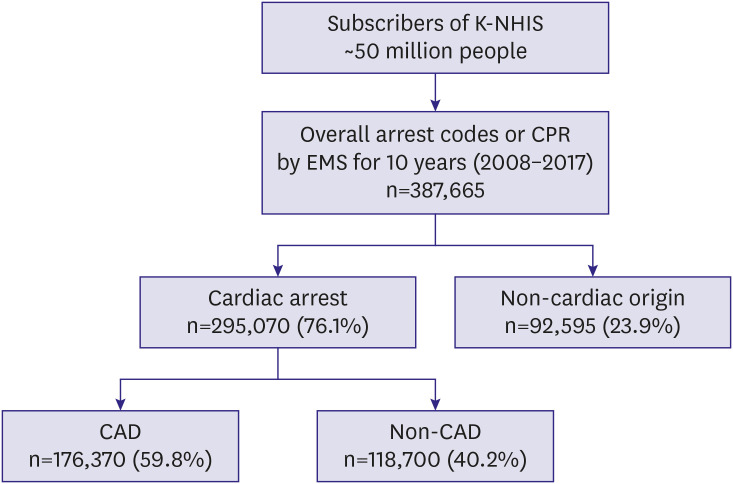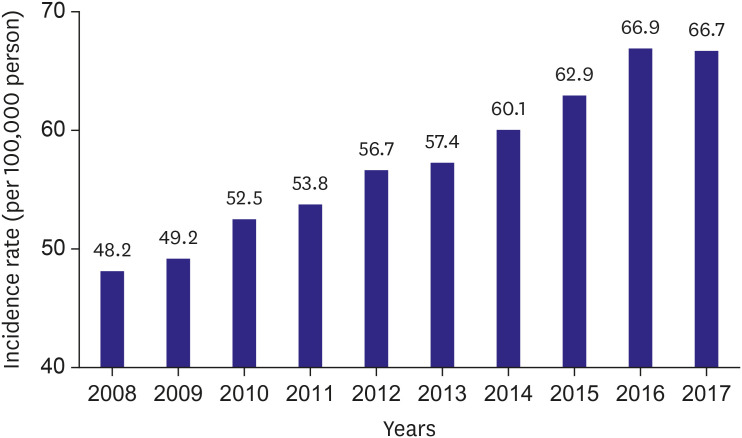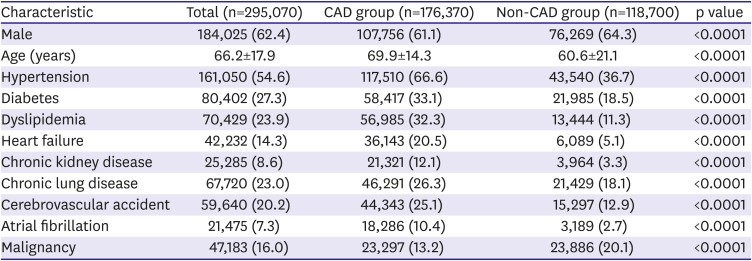1. Myat A, Song KJ, Rea T. Out-of-hospital cardiac arrest: current concepts. Lancet. 2018; 391:970–979. PMID:
29536861.

2. Malta Hansen C, Kragholm K, Pearson DA, et al. Association of bystander and first-responder intervention with survival after out-of-hospital cardiac arrest in North Carolina, 2010–2013. JAMA. 2015; 314:255–264. PMID:
26197186.

3. Girotra S, van Diepen S, Nallamothu BK, et al. Regional variation in out-of-hospital cardiac arrest survival in the United States. Circulation. 2016; 133:2159–2168. PMID:
27081119.

4. Hawkes C, Booth S, Ji C, et al. Epidemiology and outcomes from out-of-hospital cardiac arrests in England. Resuscitation. 2017; 110:133–140. PMID:
27865775.

5. El Asmar A, Dakessian A, Bachir R, El Sayed M. Out of hospital cardiac arrest outcomes: Impact of weekdays vs weekends admission on survival to hospital discharge. Resuscitation. 2019; 143:29–34. PMID:
31401136.

6. Gräsner JT, Lefering R, Koster RW, et al. EuReCa ONE-27 Nations, ONE Europe, ONE Registry: A prospective one month analysis of out-of-hospital cardiac arrest outcomes in 27 countries in Europe. Resuscitation. 2016; 105:188–195. PMID:
27321577.
7. Chan PS, McNally B, Tang F, Kellermann A; CARES Surveillance Group. Recent trends in survival from out-of-hospital cardiac arrest in the United States. Circulation. 2014; 130:1876–1882. PMID:
25399396.

8. Nichol G, Thomas E, Callaway CW, et al. Regional variation in out-of-hospital cardiac arrest incidence and outcome. JAMA. 2008; 300:1423–1431. PMID:
18812533.

9. Ong ME, Shin SD, De Souza NN, et al. Outcomes for out-of-hospital cardiac arrests across 7 countries in Asia: the Pan Asian Resuscitation Outcomes Study (PAROS). Resuscitation. 2015; 96:100–108. PMID:
26234891.

10. Hasegawa K, Tsugawa Y, Camargo CA Jr, Hiraide A, Brown DF. Regional variability in survival outcomes of out-of-hospital cardiac arrest: the All-Japan Utstein Registry. Resuscitation. 2013; 84:1099–1107. PMID:
23499636.

11. Møller SG, Wissenberg M, Møller-Hansen S, et al. Regional variation in out-of-hospital cardiac arrest: Incidence and survival - a nationwide study of regions in Denmark. Resuscitation. 2020; 148:191–199. PMID:
32004667.

12. Beck B, Bray J, Cameron P, et al. Regional variation in the characteristics, incidence and outcomes of out-of-hospital cardiac arrest in Australia and New Zealand: Results from the Aus-ROC Epistry. Resuscitation. 2018; 126:49–57. PMID:
29499230.

13. Ro YS, Shin SD, Song KJ, et al. A trend in epidemiology and outcomes of out-of-hospital cardiac arrest by urbanization level: a nationwide observational study from 2006 to 2010 in South Korea. Resuscitation. 2013; 84:547–557. PMID:
23313428.

14. Roh SY, Choi JI, Kim MS, et al. Incidence and etiology of sudden cardiac arrest in Koreans: a cohort from the national health insurance service database. PLoS One. 2020; 15:e0242799. PMID:
33237971.

15. Okubo M, Kiyohara K, Iwami T, Callaway CW, Kitamura T. Nationwide and regional trends in survival from out-of-hospital cardiac arrest in Japan: a 10-year cohort study from 2005 to 2014. Resuscitation. 2017; 115:120–128. PMID:
28392371.

16. Lim SL, Smith K, Dyson K, et al. Incidence and outcomes of out-of-hospital cardiac arrest in Singapore and Victoria: a collaborative study. J Am Heart Assoc. 2020; 9:e015981. PMID:
33094661.

17. Sasson C, Rogers MA, Dahl J, Kellermann AL. Predictors of survival from out-of-hospital cardiac arrest: a systematic review and meta-analysis. Circ Cardiovasc Qual Outcomes. 2010; 3:63–81. PMID:
20123673.
18. Berdowski J, Berg RA, Tijssen JG, Koster RW. Global incidences of out-of-hospital cardiac arrest and survival rates: systematic review of 67 prospective studies. Resuscitation. 2010; 81:1479–1487. PMID:
20828914.

19. Iwami T, Nichol G, Hiraide A, et al. Continuous improvements in “chain of survival” increased survival after out-of-hospital cardiac arrests: a large-scale population-based study. Circulation. 2009; 119:728–734. PMID:
19171854.
20. Lund-Kordahl I, Olasveengen TM, Lorem T, Samdal M, Wik L, Sunde K. Improving outcome after out-of-hospital cardiac arrest by strengthening weak links of the local Chain of Survival; quality of advanced life support and post-resuscitation care. Resuscitation. 2010; 81:422–426. PMID:
20122786.

21. Ahn KO, Shin SD, Suh GJ, et al. Epidemiology and outcomes from non-traumatic out-of-hospital cardiac arrest in Korea: a nationwide observational study. Resuscitation. 2010; 81:974–981. PMID:
20605312.

22. Yang HJ, Kim GW, Kim H, et al. Epidemiology and outcomes in out-of-hospital cardiac arrest: a report from the NEDIS-based cardiac arrest registry in Korea. J Korean Med Sci. 2015; 30:95–103. PMID:
25552889.

23. Roh SY, Choi JI, Kim MS, et al. Trends in the use of implantable cardioverter-defibrillators for prevention of sudden cardiac arrest: a South Korean nationwide population-based study. Pacing Clin Electrophysiol. 2019; 42:1086–1094. PMID:
31197835.

24. Murakoshi N, Aonuma K. Epidemiology of arrhythmias and sudden cardiac death in Asia. Circ J. 2013; 77:2419–2431. PMID:
24067274.

25. de Vreede-Swagemakers JJ, Gorgels AP, Dubois-Arbouw WI, et al. Out-of-hospital cardiac arrest in the 1990's: a population-based study in the Maastricht area on incidence, characteristics and survival. J Am Coll Cardiol. 1997; 30:1500–1505. PMID:
9362408.
26. Spain DM, Bradess VA, Mohr C. Coronary atherosclerosis as a cause of unexpected and unexplained death. An autopsy study from 1949-1959. JAMA. 1960; 174:384–388. PMID:
13833138.








 PDF
PDF Citation
Citation Print
Print



 XML Download
XML Download